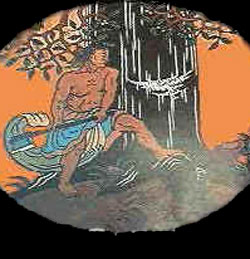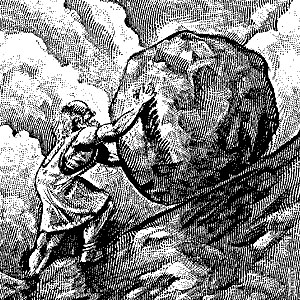we can think of myths as ways, cultural mechanisms, by which we can ask ourselves unanswerable questions.
Are our labors ceaseless, and pointless, and repetitive?
Is the glory of our labors those contemplative moments when we are momentarily free of our task?
Or, is the labor itself meant to incubate meaning?
mythslecture
counter
script type="text/javascript">
var sc_project=5992904;
var sc_invisible=0;
var sc_security="e7a15051";
Monday, June 21, 2010
Sunday, June 20, 2010
two interpretations: the conventional one, that sisyphus, because of his trickery and longing for immortality, was punished with ceaseless labor...
dante's inferno 1200
the other interpretation, from Camus, is that the absurd hero of sisyphus regains some dignity in the pause between..
and Gertrude Stein demonstrated that, at least linguistically, repeittion never is the same.
Sisyphus has then become the figure for ceaseless labor.
1) ceaseless labor is our lot in life: we are all engaged in repetitive, and unending labor--and that our labor is ultimately futile, every accomplishment, every completed task is an illusion...that it is not only exceptional trickery or inappropriate longing for immortality that condemns us to ceaseless labor, it is the nature of life itself. If we accept this, then we can adjust ourselves more easily to the labor that life entails. And if not find pleasure in it, at least accept it as necessary. The very unrewardingness of repetitive and ceaseless labor becomes, in this formulation, a kind of reward itself. We see the honoring of suffering A thousand years after HOmer wrote of Sisyphus From the6th century philosopher, Boethius. IN h is CONSOLATION OF PHILOSOPHY he promoted the idea that it was only by suffering that humans could get close to god. So suffering,a nd resignation to suffering is a strong strand in western literature, philosophy and theology.
2) An extension of this conventional interpretation of the myth by Camus says\ that we would do well, to look more closely at the pause between labors. the pivot point where in sisyphus turns and begins to go back down the mountain. If sisyphus clears his mind of the future labors, he can experience joy in that moment--the beautiful vistas from the hill, the breeze and fragrance of the plants, the relief to his aching shoulders and scratched cheek. That it is only consciousness of further labor--the prospect of further labor, the anticipation of further pain, that ruins the downward, and unburdened, stage of the labor.
Camus, writing in the 20th century, attempts to free us from the obedience, resignation, and darkness of a punishing world.
3) If it is the horror of the same task repeated endlessly that affects us, or depresses us, as readers of this myth, we might take Gertrude Stein's exploration of repetition to free ourselves from the horrifying "sameness" of Sisyphus' single task.
A rose is a rose is a rose. Ther eis no there there, or before the flowers of friendship faded friendship faded. In this frame, the repetive task is never the same, so at least the horror of Sisyphus' repetition is muted
4) Certain political philosophies, unamed, would take apart even these two 20th century interventions i (stein on repeititon, and Camus upon the glorious joy of unburdened return to the valleys] find that many myths are fundamentally conservative, in that they seek to keep us bowed to authority, and use narrowed and styilized structures of human response in order to control the society.. when these systems of control and narrowed structures keep chaos at bay, they might be thought of as positive forces, binding the society to shared values. When the systems of control and narrowed structures of acceptable human behavior are deployed for some master plan of civilization, then we might find that the myths are a negative, restricting and limiting force in society. Because the term "myth" is typically seen as "untrue"--we do have the option, individually at least, of seeing myths as deep structures of universality, as does Joseph Cambell, or as stories made up to keep the Hoi Polloi, the common people, happy in their servitude.
And if we want to look briefly at a cross-cutlural example of the "myth" of ceaseless labor. Wu Gang, a chinese figure, was
dante's inferno 1200
the other interpretation, from Camus, is that the absurd hero of sisyphus regains some dignity in the pause between..
and Gertrude Stein demonstrated that, at least linguistically, repeittion never is the same.
Sisyphus has then become the figure for ceaseless labor.
1) ceaseless labor is our lot in life: we are all engaged in repetitive, and unending labor--and that our labor is ultimately futile, every accomplishment, every completed task is an illusion...that it is not only exceptional trickery or inappropriate longing for immortality that condemns us to ceaseless labor, it is the nature of life itself. If we accept this, then we can adjust ourselves more easily to the labor that life entails. And if not find pleasure in it, at least accept it as necessary. The very unrewardingness of repetitive and ceaseless labor becomes, in this formulation, a kind of reward itself. We see the honoring of suffering A thousand years after HOmer wrote of Sisyphus From the6th century philosopher, Boethius. IN h is CONSOLATION OF PHILOSOPHY he promoted the idea that it was only by suffering that humans could get close to god. So suffering,a nd resignation to suffering is a strong strand in western literature, philosophy and theology.
2) An extension of this conventional interpretation of the myth by Camus says\ that we would do well, to look more closely at the pause between labors. the pivot point where in sisyphus turns and begins to go back down the mountain. If sisyphus clears his mind of the future labors, he can experience joy in that moment--the beautiful vistas from the hill, the breeze and fragrance of the plants, the relief to his aching shoulders and scratched cheek. That it is only consciousness of further labor--the prospect of further labor, the anticipation of further pain, that ruins the downward, and unburdened, stage of the labor.
Camus, writing in the 20th century, attempts to free us from the obedience, resignation, and darkness of a punishing world.
3) If it is the horror of the same task repeated endlessly that affects us, or depresses us, as readers of this myth, we might take Gertrude Stein's exploration of repetition to free ourselves from the horrifying "sameness" of Sisyphus' single task.
A rose is a rose is a rose. Ther eis no there there, or before the flowers of friendship faded friendship faded. In this frame, the repetive task is never the same, so at least the horror of Sisyphus' repetition is muted
4) Certain political philosophies, unamed, would take apart even these two 20th century interventions i (stein on repeititon, and Camus upon the glorious joy of unburdened return to the valleys] find that many myths are fundamentally conservative, in that they seek to keep us bowed to authority, and use narrowed and styilized structures of human response in order to control the society.. when these systems of control and narrowed structures keep chaos at bay, they might be thought of as positive forces, binding the society to shared values. When the systems of control and narrowed structures of acceptable human behavior are deployed for some master plan of civilization, then we might find that the myths are a negative, restricting and limiting force in society. Because the term "myth" is typically seen as "untrue"--we do have the option, individually at least, of seeing myths as deep structures of universality, as does Joseph Cambell, or as stories made up to keep the Hoi Polloi, the common people, happy in their servitude.
And if we want to look briefly at a cross-cutlural example of the "myth" of ceaseless labor. Wu Gang, a chinese figure, was
Gertrude Stein on repetition
A rose is a rose is a rose
There is no there, there. (oakland california)
before the flowers of friendship faded friendship faded.
There is no there, there. (oakland california)
before the flowers of friendship faded friendship faded.
Wu Gang

Wu Gang was punished for his jealousy (and murder) by being banished to the moon and there forced to cut down a bay tree. The tree, however, was self healing, and so he was never done with chopping.
what is interesting is that this is an allegory of nature (the tree) resisting, in a kind of parallel endlessness, the chopping of Wu Gang.. this is a system in balance, ever replenishing --so while the tree and the man are engaged in ceaseless labor, the system itself is intact.
Saturday, June 19, 2010
Use of the Sisyphus Myth in contemporary cartoons
Subscribe to:
Posts (Atom)



